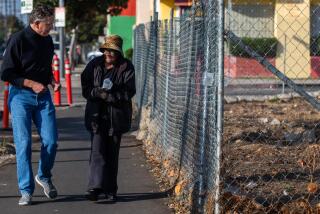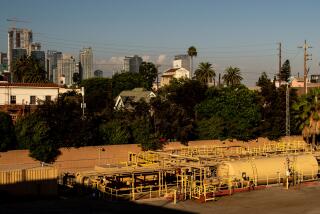MENTRYVILLE : State Landmark a Ghost of Once-Bustling Oil Town
- Share via
Mentryville. Just the name evokes an image of a bucolic town nestled amid rolling hills.
But, in this case, it’s a bucolic ghost town, the remains of an 1876 oil field settlement lying in a canyon six miles west of downtown Newhall.
Now a state historical landmark owned by Chevron USA Inc., Mentryville was the “cradle of the oil companies,” said Barbara Sitzman Cook, 64, who lived there from 1927 to 1937 while her father, Charles, worked as production superintendent of the oil fields.
“And the No. 4 well, which was the first producing well, is still pumping,” she said. “I was just up there last week, and I purposely went to check on it.”
Once Home for 100 Families
During its heyday around the turn of the century, about 100 families lived in Mentryville. No precise figures exist on how many people lived there, but some families had up to a dozen children.
The settlement was founded in the mid-1870s by Charles A. Mentry, a French oil pioneer who came to the United States and drilled wells near Titusville, Pa., where the nation’s first oil well was drilled in 1859.
But when Mentry’s well No. 4 struck black gold here, it became the first commercial oil well in California, pumping 150 barrels a day at peak. And the oil company he started, California Star Oil Works Co., evolved into Standard Oil of California and then Chevron.
After 110 years, No. 4 produces a barrel of oil a day, said Francis (Frenchy) Lagasse, a retired oil field operator. Lagasse and his wife, Carol, have been caretakers of the 852-acre property for 20 years. The well, a state and federal historical landmark, is among 13 in Pico Canyon producing thin, high-quality oil that is sold to Union Oil Co. of California, he said.
Mentryville has the trappings of a place where time has stood still--from the 1941 two-tone Chevrolet coupe parked in front of a two-story house to the cattle meandering near the red-and-white, one-room schoolhouse and matching barn.
From 1876 until the early 1930s, the town’s redwood homes were lighted and heated by gas from a local well. The main road was lighted by gas torchlights, as were tennis and croquet courts. Homes had hot running water piped in from oil company tanks.
Contributing to the settlement’s demise were the Depression and the closing in 1929 of a natural gas plant. Also, according to Carol, oil was discovered in Ventura and Whittier and many workers moved, houses in tow. Wood was costly, so workers would “tear down their houses board by board and nail by nail, because the nails were handmade, and take them all with them,” she said.
Fortunes Made, Lost
Scattered among the houses were blacksmith and machine shops, and a bakery, the foundation of which remains. Three boarding houses and a tent city accommodated the men who toiled 12 hours a day, seven days a week in the fields.
“Oil field workers in those days were paid good wages. A lot of fortunes were made and broke here,” Carol said.
Community members were close, caring for one another’s babies and sick relatives, and bartering home-grown produce for other staples.
“Every night they had something going on” in the now-demolished recreation hall, Carol said. “Box socials, potluck suppers, dances, plays. Shakespearean actors would come and entertain them. Concert pianists would come in. Senators would visit. They didn’t have a church here, but, once in a while, they had a traveling preacher.”
House Was Social Center
The superintendent’s home was a social center, and rooms often were occupied by wealthy guests, such as U. S. Sen. Charles N. Felton, for whom the local elementary school was named. A special landing was built onto the front steps so guests could step directly from a stagecoach onto cement without soiling their boots, Carol said.
Today, the 13-room house is filled with eclectic antiques. Each of the five bedrooms is decorated in a motif ranging from French to Spanish to Victorian to early American.
Before the Lagasses moved into the house, it had deteriorated and was scheduled for demolition. They persuaded Chevron to let them restore the house and care for it. Later, with help from docents in the Santa Clarita Valley Historical Society, they began giving group tours.
Artifacts Recovered
Among the collectibles the couple found during the 10-month restoration were spice and perfume bottles, fine china and porcelain dolls. They also found a rare Tippecanoe bottle from William Henry Harrison’s presidential campaign and bottles for sarsaparilla, once swilled in lieu of liquor, which was prohibited at the settlement.
Even when Cook’s family and the schoolteacher lived in the house, although it was remote, it was far from unfrequented. “We had people in and out all the time,” she said. “...We never locked that house in Pico.”
One childhood memory she recalls vividly is taking corrugated tin sheets and sliding down “Mustard Hill,” an area above the school seasonably golden with flowering mustard. “In those days, everyone bought bacon in a slab, so we used the bacon rind to grease them and then we’d come down faster.”
She counted 16 schoolmates when she was in first grade, but that number had dwindled to four by the time she was in fifth grade. In 1932, after operating since 1885, the school was closed.
Reflecting on how children in first through eighth grades were taught in one room, with the younger ones seated in the front rows, Cook said, “We learned more. Each one got their (sic)turn during the day.
“The library in the back used to be a regular L.A. County library, and the county changed the books every so often,” she added. “The teacher acted as the librarian for it.”
For recreation, “we dammed up the creek and floated on rafts,” Barbara Sitzman Cook recalled. “Then, when you got out of school, it was chase down the cow. ‘Course, we had time to hike around all these hills. And we had moonlit hikes.
“People didn’t have TVs. We would play ‘kick the can’ under torchlights.
“There used to be a dirt tennis court there, and they had torches out there--in other words, they would just have pipes and gas torches. It (gas) just came out of a pipe, and they had a tin can on top of it.”
Used as Movie Set
Over the years, episodes of “The A Team,” “Murder, She Wrote,” and “Highway to Heaven” have featured Mentryville as a set. Movies such as “Walking Tall, Part II,” cable television projects and videos have utilized the area’s ambiance and its few remaining buildings.
For 16 years, Cook, a Newhall resident, has attended all of the Mentryville reunions that draw former residents and their families back each October.
At last year’s centennial celebration of the Felton Elementary School opening, about 150 former pupils and their descendants, and a few teachers, reminisced and feasted on a catered buffet.
“It’s all like family when we get together up there,” Cook said.
“We all have fond memories of it--we had fun up there. How could we not?”
More to Read
Sign up for Essential California
The most important California stories and recommendations in your inbox every morning.
You may occasionally receive promotional content from the Los Angeles Times.













